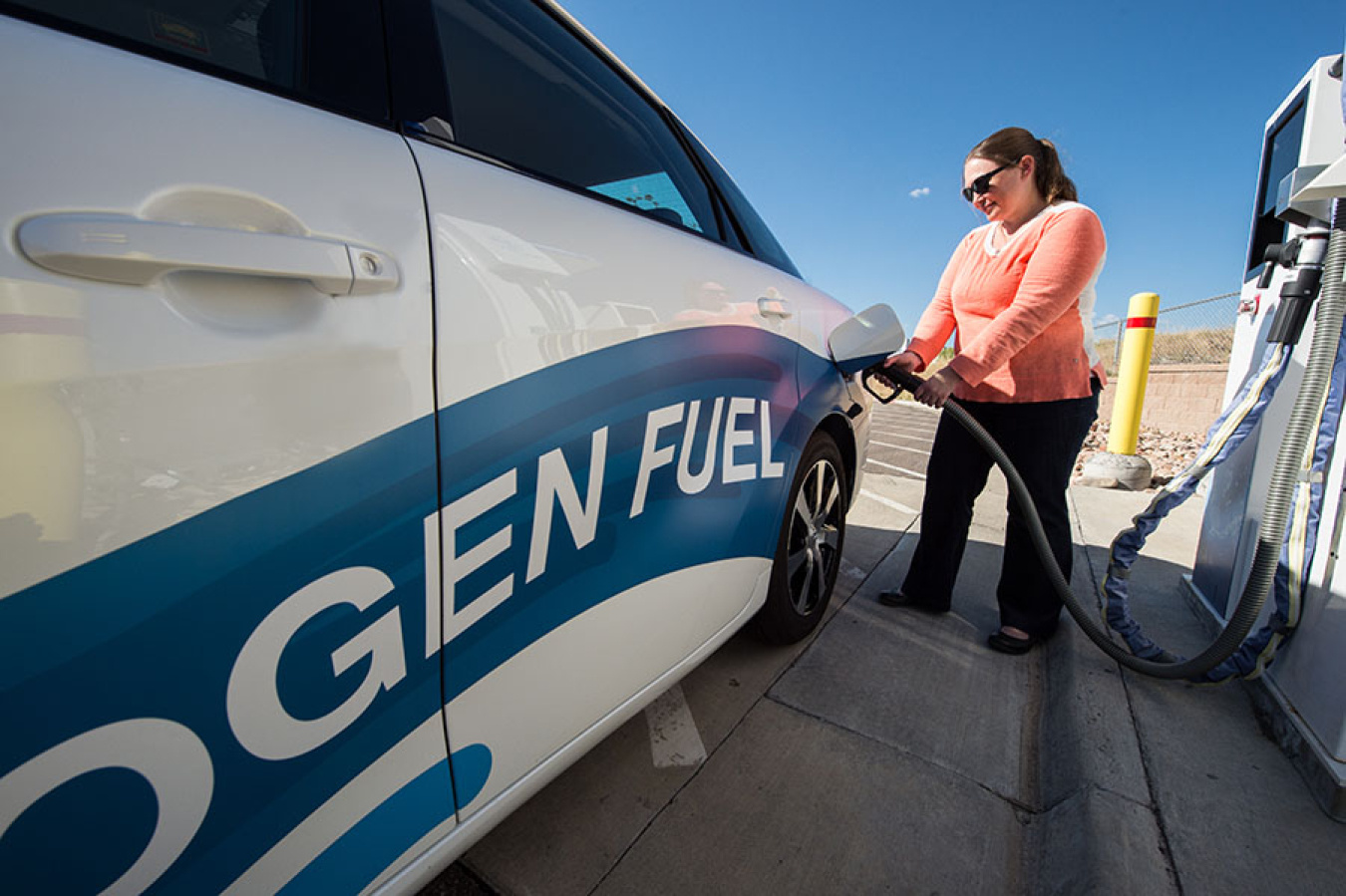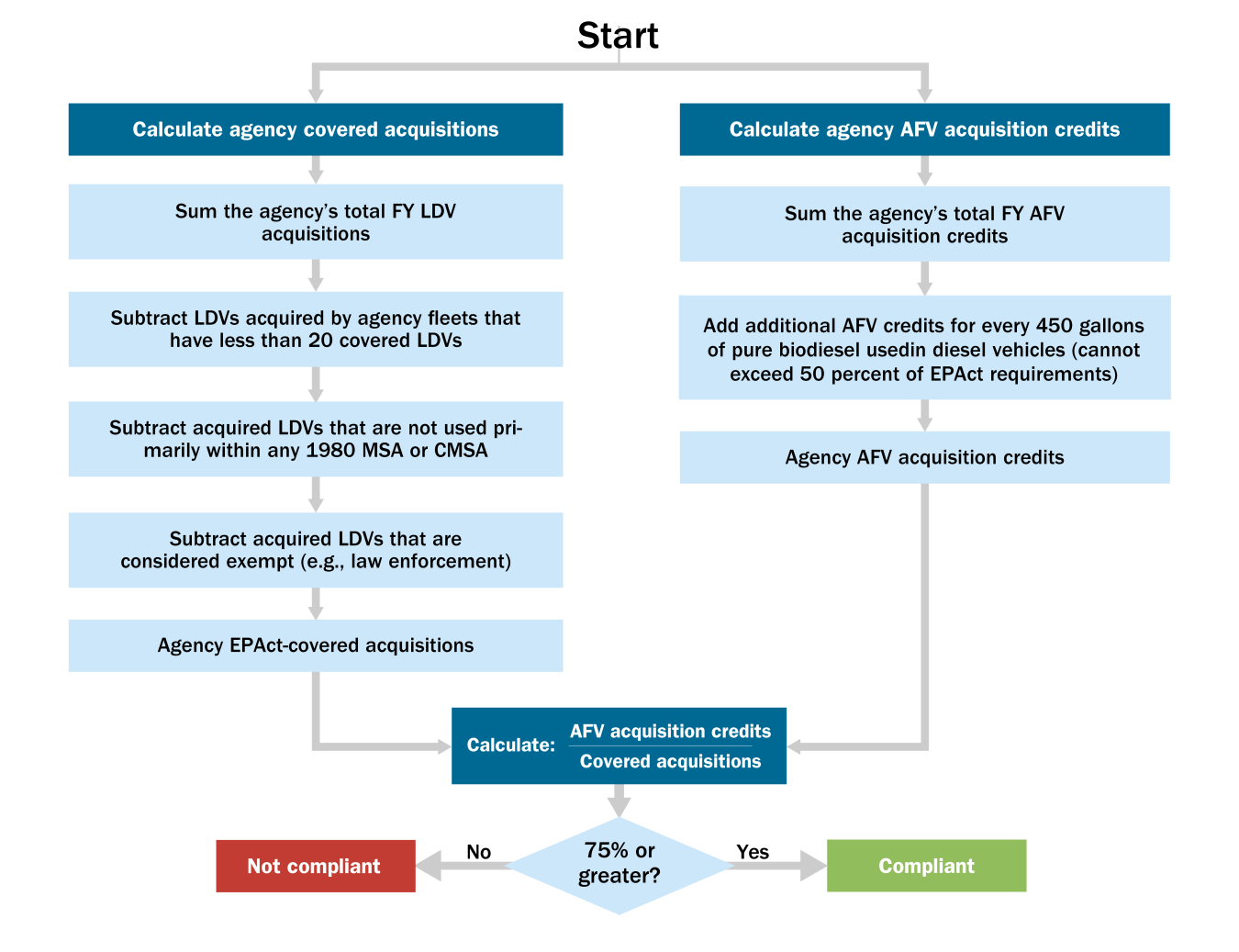ON THIS PAGE
- EPAct 1992 Statutory Requirements for Acquiring Alternative Fuel Vehicles
- EPAct 1992 Applicability
- FEMP Resources and Best Practices
EPAct 1992 Statutory Requirements for Acquiring Alternative Fuel Vehicles
Section 303 of the Energy Policy Act (EPAct) of 1992 (42 U.S.C. 13212(b)) says:
"(b) Percentage Requirements
(1) Of the total number of vehicles acquired by a Federal fleet, at least—
(A) 25 percent in fiscal year 1996;
(B) 33 percent in fiscal year 1997;
(C) 50 percent in fiscal year 1998; and
(D) 75 percent in fiscal year 1999 and thereafter, shall be alternative fueled vehicles."
(2) The Secretary, in consultation with the Administrator of General Services where appropriate, may permit a Federal fleet to acquire a smaller percentage than is required in paragraph (1), so long as the aggregate percentage acquired by all Federal fleets is at least equal to the required percentage.
(3) For purposes of this subsection, the term "Federal fleet" means 20 or more light duty motor vehicles, located in a metropolitan statistical area or consolidated metropolitan statistical area, as established by the Bureau of the Census, with a 1980 population of more than 250,000, that are centrally fueled or capable of being centrally fueled and are owned, operated, leased, or otherwise controlled by or assigned to any Federal executive department, military department, Government corporation, independent establishment, or executive agency, the United States Postal Service, the Congress, the courts of the United States, or the Executive Office of the President. Such term does not include—
(A) motor vehicles held for lease or rental to the general public;
(B) motor vehicles used for motor vehicle manufacturer product evaluations or tests;
(C) law enforcement vehicles;
(D) emergency vehicles;
(E) motor vehicles acquired and used for military purposes that the Secretary of Defense has certified to the Secretary must be exempt for national security reasons; or
(F) nonroad vehicles, including farm and construction vehicles."
EPAct 1992 Applicability
See the Applicability page to determine which agencies and vehicles are subject to EPAct 1992 AFV acquisition requirements.
FEMP Resources and Best Practices

Summary of Requirements
Section 303 of EPAct 1992 requires that at least 75% of covered light-duty vehicle (LDV) acquisitions by Federal agencies be alternative fuel vehicles (AFVs). These requirements apply to agency fleets of 20 or more LDVs that are centrally fueled and operated in a Metropolitan Statistical Area (MSA)/Consolidated Metropolitan Statistical Area (CMSA).
How Is an AFV Defined under EPAct 1992?

EPAct 1992 defined AFVs as any dedicated vehicle or dual-fueled vehicle designed to run on at least one alternative fuel. Section 2862 of the National Defense Authorization Act for FY 2008 (NDAA 2008) amended EPAct 1992 by adding the following new vehicles to the definition of AFV (as that definition applied to Federal fleets):
- A new qualified fuel cell motor vehicle
- A new advanced lean burn technology motor vehicle
- A new qualified hybrid motor vehicle
- Any other type of vehicle that the Administrator of the EPA demonstrates to the Secretary of Energy would achieve a significant reduction in petroleum consumption.
Based on the demonstration EPA made to DOE and the objectives of EPAct 1992, any low GHG-emitting vehicle acquired in a location that would qualify for an EPAct 2005 Section 701 fuel waiver based on garage location is included in the expanded definition of an AFV and can count toward an agency’s EPAct 1992 AFV acquisition credits. Each agency head, or his or her designee(s), determines if the agency's FFVs at that location would qualify for a fuel waiver based on the criteria established by DOE. Unless an exception to EISA Section 141 is utilized, all FFVs acquired must be low GHG-emitting vehicles.
In accordance with Section 2862 of NDAA 2008, the U.S. Environmental Protection Agency (EPA) demonstrated to the U.S. Department of Energy (DOE) in December 2008 that operating a low greenhouse gas (GHG)-emitting vehicle, as defined in the U.S. Environmental Protection Agency (EPA) Energy Independence and Security Act (EISA) Section 141 guidance, would achieve a significant reduction in petroleum consumption similar to or greater than the other newly defined AFVs that are commercially available (i.e., advanced lean burn and hybrid vehicles), and a significant reduction in petroleum consumption compared to existing flexible fuel vehicles (FFVs) operating on gasoline.
Below is a list of the current vehicles defined as AFVs in the Federal fleet that can earn EPAct 1992 AFV acquisition credits. Agencies do not receive AFV acquisition credits for vehicles exempt from the EPAct 1992 AFV acquisition requirements such as LE and emergency vehicles.
Vehicles Currently Defined as Alternative Fuel Vehicles in the Federal Fleet (by Vehicle Type):
- E85 FFVs
- Compressed natural gas vehicles
- Liquefied natural gas vehicles
- Liquid petroleum gas or propane vehicles
- Battery electric vehicles
- Plug-in hybrid electric vehicles
- Hybrid electric vehicles
- Hydrogen fuel cell electric vehicles
- Lean burn technology vehicles
- Low GHG-emitting vehicles (only in locations that would qualify for a fuel waiver based on garage location under EPAct 2005 Section 701)
- Other vehicles achieving significant reduction in petroleum consumption.
Federal Automotive Statistical Tool (FAST) Vehicle Classifications
Light-duty vehicles include both passenger cars and light-duty trucks at or under 8,500 lbs GVWR.
Medium-duty vehicles include all vehicles between 8,501 lbs and 16,000 lbs GVWR.
Heavy-duty vehicles include all vehicles over 16,000 lbs GVWR.
Measuring Compliance
Each fiscal year (FY), the number of AFVs (or AFV credits) that each agency (i.e., those agencies subject to the EPAct 1992 AFV requirements) acquires must represent at least 75% of new non-exempt LDV acquisitions in covered fleet locations during that FY.
Compliance with the EPAct 1992 AFV acquisition requirements is measured based on AFV acquisition credits, which are earned based on the acquisition of any non-exempt light-, medium-, or heavy-duty AFV or quantity of biodiesel used by the agency during that FY. Agencies must accumulate 75 credits per 100 covered vehicles acquired within each FY to comply. Covered vehicle acquisitions include the total annual acquisition of LDVs deployed and operated in covered fleet locations (i.e., agency fleets of 20 or more LDVs that are centrally fueled or capable of being centrally fueled and are primarily operated in an MSA/CMSA) that the agency has not exempted (e.g., law enforcement [LE] or emergency response vehicles).
The figure below outlines the process for determining compliance with the EPAct AFV acquisition requirements. The requirement for AFV acquisition credits that agencies must accumulate each FY is based on the number of covered vehicles acquired during that FY. To comply, agencies must accumulate 75 credits per 100 covered vehicles acquired within each FY. The sections below detail the calculation of agency covered vehicle acquisitions and agency AFV acquisition credits.

Determining Compliance with EPAct 1992 Alternative Fuel Vehicle Acquisition Requirements
Calculating the number of covered vehicle acquisitions starts with summing all agency domestic LDV acquisitions during the FY. Agencies then subtract all non-covered acquisitions, which include vehicles that are: (1) deployed and operated in agency fleets of less than 20 LDVs; (2) not primarily operated in an MSA/CMSA based on garage location or vehicle operation, or are not centrally fueled or capable of being centrally fueled; (3) considered exempt from the EPAct 1992 AFV acquisition requirements (some vehicle exemptions apply). The calculation is automatically completed for each agency in FAST.
Agencies accumulate AFV acquisition credits based on the acquisition of AFVs or quantity of biodiesel used by the agency during that FY. Agencies receive one acquisition credit for each non-exempt AFV they acquire each FY, which includes all domestic light-, medium-, or heavy-duty AFVs (listed in the table above). Agencies do not receive AFV acquisition credits for vehicles exempt from the EPAct 1992 AFV acquisition requirements, such as LE and emergency vehicles.
Federal agencies do not receive EPAct 1992 AFV acquisition credits for low-speed electric vehicles (LSEVs) because they do not meet the definition of "motor vehicle" in 42 U.S.C. § 7550.
The Energy Conservation Reauthorization Act of 1998 (ECRA) (42 U.S.C. § 13220) amended EPAct 1992 by allocating one acquisition credit to Federal agencies for every 450 gallons of pure biodiesel or renewable diesel (equivalent to 2,250 gallons of B20 or R20) used in fleet vehicles. The biodiesel and renewable diesel counted only includes the biodiesel or renewable diesel component of blends greater than 20% used in non-exempt vehicles in the United States. Biodiesel fuel use credits may account for no more than 50% of a fleet’s annual AFV acquisition requirements (i.e., 37.5% of covered acquisitions).
Compliance with the EPAct 1992 AFV acquisition requirement is determined using total AFV credits as a percentage of covered acquisitions, calculated by dividing the total number of AFV acquisition credits accumulated by the number of covered acquisitions by the agency during the FY. Agencies are in compliance if the number of AFV acquisition credits divided by covered acquisitions is 75% or greater. In other words, agencies must accumulate 75 AFV acquisition credits per 100 covered vehicles acquired within each FY to comply.
FAST includes EPAct AFV acquisition compliance reports under the "Reports" tab for authorized users. Note that FAST rounds AFV acquisition compliance to the nearest whole percentage. More detail about how FAST calculates EPAct AFV acquisition compliance is available in the FAST General Frequently Asked Questions.
Reporting
To track compliance with the EPAct 1992 AFV acquisition requirements, Federal agencies are required to collect and report accurate annual vehicle acquisition and inventory data in FAST. This data will be used in FAST to automatically calculate annual compliance with the EPAct 1992 AFV acquisition requirements. Fleets must input annual vehicle acquisition and inventory data into FAST each year; the reporting period begins on roughly October 1 and closes in mid-December.
Agencies are required to collect and manage annual asset-level data (ALD) (per vehicle rather than aggregated fleet data) in a formal agency fleet management system, and submit relevant data managed in that system to FAST. Agencies must upload vehicle ALD from their fleet management system to FAST using a standardized file structure, which includes vehicle inventory, acquisition, cost, mileage and fuel use information for each vehicle. Agencies should ensure the required asset-level information in their fleet management system is finalized and reported to FAST well in advance of the mid-December deadline. Timely reporting will allow agency headquarters personnel ample opportunity to review the data for completeness and accuracy prior to final submission.

